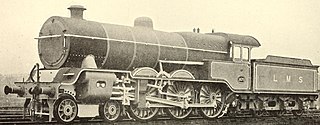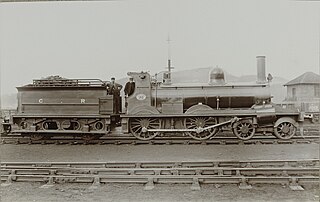Related Research Articles

The Highland Railway's Clan Goods class was a class of steam locomotive. They were designed by Christopher Cumming. The first four were built by Hawthorn Leslie and Company on Tyneside, and the maker's plates bore the date 1917, but because of wartime delays were not delivered until 1918. Four more were built in 1919, also by Hawthorn Leslie.

The Highland Railway's Clan Class was a class of passenger 4-6-0 steam locomotives designed by Christopher Cumming. The design is derived from that of the slightly earlier Clan Goods although the similarity is more visual than real. The first four were built in 1919, and the remaining four in 1921.

The Highland Railway Loch class locomotives were large 4-4-0s normally used north of Inverness. They were introduced in 1896, to the design of David Jones. Fifteen were built by Dübs and Company in Glasgow, all going into traffic between July and September 1896. Three more were built in 1917 by Dübs' successor, the North British Locomotive Company (NBL).

The Highland Railway F class 4-4-0s were a class of British steam locomotives introduced in 1874. The first 10 were built by Dübs and Company in 1874. A further seven were built in Lochgorm works between 1876 and 1888. Originally they were the first Bruce class, and later became known as the Duke class to avoid confusion with the second Bruce class. As part of Peter Drummond's 1901 classification scheme they became class F.

The Highland Railway L class, also known as ‘Skye Bogies’ due to their association with the Kyle of Lochalsh Line. They were essentially mixed traffic versions of the earlier Duke or F class.
The Highland Railway E Class was a class of 4-4-0 steam locomotive designed by David Jones for passenger service. They were also known as the 'Clyde Bogies' as they were built by the Clyde Locomotive Company in Glasgow, Scotland. They were the first locomotives built by that company.

The Highland Railway P class was a group of five 4-4-0T steam locomotives built in 1891 and 1893 by Dübs and Company of Glasgow.
The Highland Railway Strath Class were 4-4-0 steam locomotives introduced in 1892, to the design of David Jones.

The Highland Railway Jones Goods class was a class of steam locomotive, and was notable as the first class with a 4-6-0 wheel arrangement in the British Isles. Fifteen were built, and one has survived to preservation. Originally known as the Big Goods class, they became class I under Peter Drummond's 1901 classification scheme.

The London and North Western Railway (LNWR) Improved Precedent Class or Renewed Precedent Class is a class of 2-4-0 steam locomotives originally designed for express passenger work. They later gained the nickname of Jumbos.

The Lancashire and Yorkshire Railway (L&YR) Class 8 was a four-cylinder 4-6-0 express passenger locomotive designed by George Hughes introduced in 1908.
The Midland Railway Johnson 0-6-0 were a class of locomotives serving Britain's Midland Railway system in the late 19th and early 20th centuries. Between 1875 and 1908 the Midland Railway, under the control of locomotive superintendents Samuel Waite Johnson and Richard Deeley, ordered 935 goods tender engines of 0-6-0 type, both from the railway's own shops at Derby and various external suppliers. Although there were many variations between different batches both as delivered and as successively rebuilt, all 935 can be regarded as a single series, one of the largest classes of engine on Britain's railways. The locomotives served as late as 1964, but none of them now survive.

The Midland Railway 1252 class was a class of thirty 0-4-4T locomotives built by Neilson and Company in 1875–1876 to the design of Samuel Waite Johnson. They were a development of the 6 Class. Originally numbers 1262–1281 and 1252–1261. Under the Midland Railway's 1907 renumbering scheme they became 1236–1265.
The Highland Railway Cumming 4-4-0 class was a pair of 4-4-0 steam locomotives designed by Christopher Cumming, the Locomotive Superintendent of the Highland Railway
The locomotives of the Highland Railway were used by the Highland Railway to operate its lines in the north of Scotland. The Highland Railway locomotive works was at Lochgorm, Inverness. The works had been built about 1855 by the Inverness and Nairn Railway. The locomotive classes are listed under the names of the railway's Locomotive Superintendents.

The Caledonian Railway 179 Class was a class of 4-4-0 steam locomotives designed by George Brittain for the Caledonian Railway (CR) and introduced in 1882.

The LNWR 4ft 6in Tank was a class of 220 passenger 2-4-2T locomotives manufactured by the London and North Western Railway in their Crewe Works between 1879 and 1898. The "4ft 6in" in the title referred to the diameter of the driving wheels – although the stated dimension was for the wheel centres – the nominal diameter including the tyres was 4 ft 8+1⁄2 in (1,435 mm).

The Midland Railway 1121 class was a class of 0-6-0T tank locomotives designed by Samuel W. Johnson for the Midland Railway. Fifty-five were built between 1895 and 1900: ten by the railway company's Derby Works, five by Sharp, Stewart and Company, and the remaining forty by Robert Stephenson and Company.

The LNWR 18-inch Goods was a class of 310 0-6-0 freight steam locomotives built by the London and North Western Railway at their Crewe Works between 1880 and 1902.

The LNWR 5ft 6in Tank was a class of 160 passenger 2-4-2T locomotives manufactured by the London and North Western Railway in their Crewe Works between 1890 and 1897. The "5ft 6in" in the title referred to the diameter of the driving wheels – although the stated dimension was for the wheel centres – the nominal diameter including the tyres was 5 ft 8+1⁄2 in (1,740 mm).
References
- Baxter, Bertram (1984). Baxter, David (ed.). British Locomotive Catalogue 1825–1923, Volume 4: Scottish and remaining English Companies in the LMS Group. Ashbourne, Derbyshire: Moorland Publishing Company. p. 195.
- Casserley, H. C. & Johnston, Stuart W. (1974) [1966]. Locomotives at the Grouping 3: London, Midland and Scottish Railway. Shepperton, Surrey: Ian Allan. p. 153. ISBN 0-7110-0554-0.
- H. A. Vallance (1938) The Highland Railway